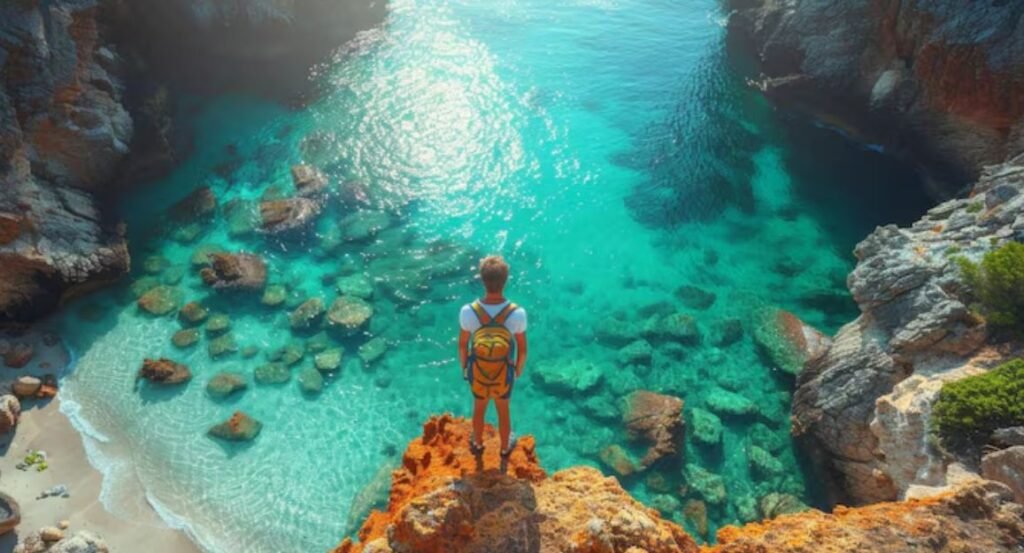
Artificial islands are subtly changing the way tourism develops along glistening coastlines by fusing human ingenuity with the attraction of the sea. In addition to being engineering marvels, these buildings are emblems of rebirth—new ground made to meet the ever-increasing demand for upscale travel, opulent living, and environmentally friendly development.
Countries are creating new shorelines and transforming aspirations into physical geography by utilizing sophisticated dredging techniques. The most recognizable image of this trend is still Palm Jumeirah in Dubai, an island shaped like a palm that was built out of more than 120 million cubic meters of sand. Beyond its beauty, it symbolizes a more significant economic turn, moving the United Arab Emirates away from oil and toward hospitality. Due to the impact’s remarkable effectiveness, tourism now accounts for a sizeable portion of the country’s GDP.
| Category | Details |
|---|---|
| Definition | Artificial islands are man-made landforms created through dredging, sediment layering, or coastal expansion for tourism, real estate, and infrastructure. |
| Key Examples | Palm Jumeirah (Dubai), The Pearl (Qatar), Ocean Flower Island (China), Hulhumalé (Maldives). |
| Economic Drivers | Tourism growth, investment diversification, urban expansion, and sustainable infrastructure. |
| Environmental Purpose | Climate resilience, new land creation, and adaptation to sea-level rise. |
| Challenges | Environmental impact, maintenance costs, and regulatory limitations. |
| Benefits | Job creation, luxury tourism, renewable energy potential, and increased land availability. |
| Leading Innovators | DEME, Jan De Nul, Nakheel Properties, CCCC Dredging, and Van Oord. |
| Future Outlook | Projected surge in eco-tourism, renewable-powered resorts, and floating city concepts. |
| Social Impact | Supports housing, mitigates urban pressure, and introduces sustainable tourism models. |
| Reference Source | Central Dredging Association – https://www.dredging.org/news/artificial-islands-big-payoffs |
Other nations have adopted similar goals in recent years. Built off the coast of Hainan Province, China’s Ocean Flower Island is a vast leisure destination featuring theaters, museums, and opulent homes. It’s especially creative at fusing urban sophistication with a coastal getaway, showing how man-made islands can provide both substance and spectacle. According to developers, it will draw millions of domestic tourists each year, bolstering China’s tourism autonomy and broadening its economic base.
Another strong argument is made by the Maldives. The island nation is growing its tourism industry while establishing new land to protect its people from the rising sea levels. Reclamation can be both a survival tactic and a growth strategy, as demonstrated by initiatives like Hulhumalé. These recently constructed islands, which incorporate solar energy, smart housing, and eco-luxury resorts that inspire locals and tourists alike, are remarkably obvious examples of climate adaptation turned into opportunity.
Building artificial islands gives nations a narrative of innovation in addition to real estate. Every project offers travelers places where elegance and environmental consciousness coexist, demonstrating tenacity and foresight. The combination is especially advantageous in a market that is becoming more and more influenced by ethical luxury, where travelers are looking for unique experiences that support sustainability.
Artificial islands serve as investment magnets from an economic perspective. They generate jobs and stimulate auxiliary industries by establishing new tourism economies that extend well beyond their borders. For example, The Pearl in Qatar has developed into a center for global shopping and dining, illustrating how prudent growth can result in long-term success. These kinds of projects are very effective at transforming unused coastal areas into vibrant commercial and cultural ecosystems.
In terms of architecture, man-made islands offer a freedom that is uncommon in natural settings. Designers experiment with biophilic areas that blend in perfectly with the sky and sea, floating villas, and flowing geometries. The visual and experiential quality of contemporary tourism spaces has significantly improved as a result of this move toward more organic, human-centered architecture. These projects are imaginative playgrounds for engineers and architects, where infrastructure and art coexist in strikingly successful harmony.
By making significant investments in these initiatives, celebrities and businesspeople have accelerated the trend. Prominent individuals, ranging from tech titans to movie stars, are investing in real estate on artificial islands as a declaration of environmental optimism as well as a status symbol. Their participation adds a sense of aspiration to artificial islands and piques public interest. These exclusive communities are now discussions about the direction of sustainable living rather than merely places to retreat.
However, environmental issues continue to be at the forefront of the discussion. Although dredging has long been criticized for disturbing marine habitats, technology has greatly improved. These days, reclamation techniques are noticeably less intrusive and more accurate. Environmentally conscious methods have been invented by businesses like Jan De Nul and DEME, guaranteeing water purity and biodiversity preservation. Artificial islands are evolving from ecological hazards to regeneration labs through the use of adaptive marine design.
The creation of artificial islands is a proactive adaptation strategy in light of the global climate challenges. Instead of letting coastlines erode, countries are taking back control and literally reshaping their futures, layer by layer. The possibilities go well beyond travel. Certain projects, such as Princess Elisabeth Island in Belgium, are being constructed to house offshore wind power infrastructure, supplying whole cities with renewable energy. This multifunctional design is especially creative because it demonstrates how energy, sustainability, and tourism can all coexist on one platform.
It is impossible to exaggerate how these projects benefit the economy and the environment. Artificial islands have transformed over the last ten years from ostentatious experiments to essential growth engines. They have created new avenues for global collaboration and greatly decreased reliance on limited land resources. In order to guarantee that future developments continue to be both profitable and environmentally responsible, governments, investors, and environmental organizations are now collaborating.
Socially, these islands are changing how people think about belonging and space. Artificial land provides a lifeline in areas that are experiencing a housing shortage. Reclamation projects that strike a balance between housing demand and recreational access have already been put into place by urban planners in Singapore and the Netherlands, guaranteeing that quality of life is always at the forefront of development. This strategy promises urban growth without sacrificing inland areas, making it both visionary and practical for coastal nations.
In the end, the emergence of artificial islands is a reflection of humanity’s remarkable ability to adapt and create. They are more than just places to visit; they are declarations about aspiration, technology, and the capacity to coexist peacefully with nature while simultaneously reimagining it. Artificial islands are dazzling examples of what can be achieved when creativity and necessity come together, as tourism continues to shift toward experiences based on sustainability.
They serve as a reminder that creativity frequently starts where the land ends. These islands demonstrate that the future of tourism will not be discovered by looking back, but rather by moving forward, one dredged grain of sand at a time, by transforming oceans into opportunities.
